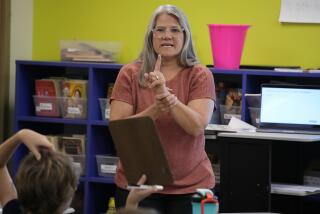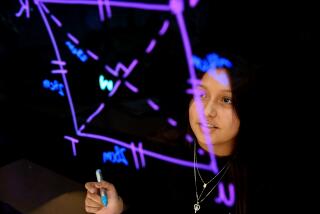A Calculated Effort
- Share via
GLENDALE — Determined to light young minds with the brilliance of a man long dead, Sid Kolpas urged his students to apply Sir Isaac Newton’s genius to a mock murder.
A body is found outside a house, according to a problem he gave to his Glendale City College students. It is noon, 70 degrees and the temperature of the corpse is 80.6.
When did the killer strike?
To the veteran educator’s satisfaction, the commuter-college students plunged without hesitation into the 300-year-old arcana of differential equations to calculate the time of death.
The students included some unlikely candidates: a young man with wildly spiked hair, and a high school dropout who once labored in a boom box factory, among others.
Not to be outdone in using new approaches to old problems, Kolpas and fellow mathematics professor Steve Marsden have discovered what they believe is a novel proof of a random mathematical experiment that always results in the number 2.718, a kind of relative of pi, which is a ratio that corresponds to 3.1416. Their work soon will be published by the American Mathematical Assn. of Two Year Colleges.
While admittedly nothing earthshaking--even within the esoteric world of academic mathematics--the two professors’ sally into the fourth and fifth dimensions and beyond is significant to their students, they suggested, because it demonstrates the intoxicating mix of solutions at their fingertips, both in math and elsewhere.
Gary Pis, 22, agreed. “I struggled throughout in my earlier [math] courses, but not any more,” the Glendale man said outside Kolpas’ cluttered office, where Pis and two classmates had huddled over a glowing computer screen as if it were an oracular fire.
“[Kolpas] has shown there’s not just one way of doing something. Maybe one’s the long way and maybe another’s the short one,” said Pis, who plans to transfer to Cal Poly Pomona this fall to major in mechanical engineering. “There’s not just one right way to solve problems. There are a lot of ways.”
*
The same goes for the professors’ proof. Long verified through nongeometric--or number theory--methods, the random mathematical experiment was proven by Kolpas and Marsden through multidimensional calculus and probability theory, they said. Neither could find any evidence that their proof had previously been demonstrated.
Although he had yet to review the professors’ paper, mathematics professor Zalman Usiskin of the University of Chicago said of the new proof, “I think it’s one of those nice little results that mathematicians enjoy. In some ways, it’s like finding historic documents that explain an event that had not been explained before.”
In one version of the experiment, a subject pushes the random button on a calculator to get decimals that add up to 1.0 or more. The decimals could be .3, .5 and .4, for example, meaning it took three tries to reach or surpass 1.0. The subject repeats this a number of times--10, 100, a million--and then averages the number of tries necessary each time to reach 1.0 or beyond.
Without fail, the average of tries equals 2.718, or the “e” number, a cousin of pi that is present in calculations of compound interest, radioactive decay or biological growth, whether of cells or of human population, Kolpas said.
“The proof isn’t a revolutionary new concept in mathematics, but we’re proud of the fact that it’s a very creative proof,” said Marsden, 45, chairman of the two-year college’s math division. “What’s more important is that this shows [the students] . . . that sometimes you have to extend beyond your natural boundaries to solve a problem, to go into another world.”
And what better way than math?
Unencumbered by the body, the magic carpet of math can take flight to any dimension, any universe, Kolpas said, to retrieve insights that can illuminate the otherwise murky workings of the material world.
“Galileo said mathematics is the language in which God has written the universe,” said Kolpas, 49, who has taught math for 26 years. “The question has been asked: Is math an invention of human beings or is it man’s unfolding of God’s laws or nature’s laws? . . . My contention is that it’s always been there.”
To show the mystery and the relevance of math, Kolpas often tries to bring a tangible, earthly meaning to the abstract world of numbers and formulas and theorems, he said.
One example is the murder problem. Another is an ecological project in which students use differential equations to analyze the interrelationships of coyotes, rabbits and vegetation in a chaparral environment. What is the threshold of each species’ population?
*
Hiram De Los Rios, one of the students given the problem, said he has found math easier to master the higher he goes in the discipline. The 25-year-old North Hollywood man said he wants to go to a four-year college to study biomedical engineering, a far cry from the odd jobs--car detailer, house painter, factory worker, carwash hand--that he has taken since dropping out of Hoover High School in his junior year.
“If you ask me about my career, that’s what I’d like to be known for the most, helping kids find that they can master math,” said Marsden, who has taught the subject for 22 years.
“That’s one of the myths that people have, that you have to have a math mind to do it. . . . [But] attitude is more important than aptitude,” he said.
(BEGIN TEXT OF INFOBOX / INFOGRAPHIC)
Finding a Solution
Two Glendale City College professors discovered what they believe to be a novel proof of a random experiment that always results in the number 2.718. Shown below is a portion fo the proof:
Source: Glendale City College
More to Read
Sign up for Essential California
The most important California stories and recommendations in your inbox every morning.
You may occasionally receive promotional content from the Los Angeles Times.










